The Portland Bureau of Transportation has closed the book (for now) on the public process for their $2.4 million federally funded 20s Bikeway Project. For the past nine months, the city has convened an advisory committee whose goal was to develop a plan for the north-south route. At the group’s final meeting in southeast Portland last night, members agreed to support PBOT’s current proposal which utilizes a mix of bike lanes, buffered bike lanes, and neighborhood greenway treatments on a corridor bound by 26th and 32nd Avenues from the Springwater Corridor to NE Lombard Street.
As we’ve covered at length here on the Front Page, the most complicated and contentious segment of the project has been the central section on 28th Avenue that goes through a commercial district. At the meeting last night, PBOT Project Manager Rich Newlands said the city’s approach to this section from the get-go was to create an alternative to 28th that would give less daring riders a lower-stress option. Newlands denied the idea that PBOT gave up on a separated bikeway facility on 28th solely in response to a pro-parking petition signed by business owners along the street. “I really need to stress… That’s not how this played out,” he said. “We made that decision long before we received the petition.” Newlands claimed that PBOT has been aware of the “significant land-use issue” (a.k.a. 28th Avenue’s narrow width and high on-street parking demand) all along. “The petition confirmed, but didn’t change our understanding of those issues,” he said.
“This looks great! It’s the best thing I’ve seen so far! Bravo!”
— Scott Mapes, owner of La Buca restaurant, responding to a presentation on the commercial greenway concept
Earlier this year PBOT put forward an option that would have created a buffered bike lane on 28th, in lieu of the existing on-street parking lane, but only in the southbound direction. Bicycling northbound would be a shared environment similar to what exists today. Addressing the buffered bike lane proposal at last night’s meeting, Newlands said it simply never gained enough traction. “No business owner had approached us to support this. In exchange for a lot of on-street parking removal [about 100 spaces], you only got direct access in one direction. The couplet idea just didn’t resonate.”
PBOT’s proposal that was supported by the SAC last night will be to create a neighborhood greenway on 30th and keep 28th as an “enhanced shared roadway.” To try and calm traffic and make bicycling on 28th more pleasant than it is today, PBOT will install sharrows, crosswalks and fire-friendly speed humps, and reduce the speed limit to 20 mph.
Many people want to see low-stress bicycle access on 28th (instead of two blocks over) and there remains skepticism that the current plan will create conditions that will further our goal of 25% bicycle use by 2030. PBOT themselves acknowledges this. In explaining why they’re investing in 30th as alternate route, Newlands said that, “Even if we could achieve a really great enhanced, shared environment on 28th — which I’m hoping… we can do a dramatic improvement — it would still not meet our threshold for the ‘interested but concerned’.”
Advertisement
Given the limitations in PBOT’s plans and the absence of political or public will to remove auto parking on both sides of 28th in order to install a separated bike lane, a new idea has emerged: the “commercial greenway” concept. Introduced here yesterday by Kirk Paulsen (and co-created by his colleagues Nick Falbo, and Brian Davis), the idea is to put PBOT’s “enhanced shared roadway” on steroids.
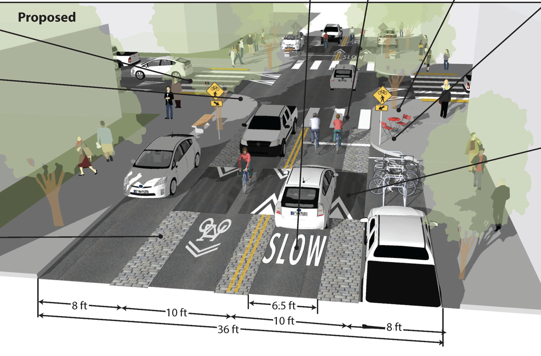
In a nutshell, the commercial greenway would create an environment with very low speeds (around 10 mph) that would transform 28th into a place (not just a street to travel through) where road users feel safe and relaxed whether on a bike, in a car, or on foot.
PBOT let Paulsen and Davis present the idea at the meeting last night and it was very well received by several SAC members and at least one business owner. (The reaction echoed the broad support for the idea we’ve had in the comments here on BikePortland.)
Scott Mapes, owner of La Buca restaurant at 28th and Couch, stood up and said, “This looks great! It’s the best thing I’ve seen so far! Bravo!” (It’s worth noting that Mapes was one of 60 business owners who signed the petition against parking removal.)
Even SAC members who had hoped for a separated bikeway agreed that the commercial greenway concept was a great idea. Rob Sadowsky with the Bicycle Transportation Alliance (who had said the southbound buffered bike lane was a “smart compromise”), supported the idea. Sadowsky added that he’s disappointed PBOT didn’t take the opportunity for a dedicated bikeway and that he’s “not sure” the city’s current plans are “ripe for success”. SAC member Brendon Haggerty also said he’s disappointed at the outcome; but that the idea presented by Paulsen is the “next best option.” “I feel like parking is ruling the day, Haggerty continued. “That said, I would have liked to see us be bold with a separated facility; but what I saw tonight from Kirk and Brian is the immediate, next best option.”
Haggerty then got a laugh when, referring to parking, he said, “I realize it [the commercial greenway concept] is more expensive, which makes me wish we had a scarce resource that is very valued.”
“For those of you who feel like we’re missing our goals by not providing separated bike facilities on 28th, we just don’t feel we have a defensible argument to go in that direction until these questions [about parking] are answered. We got to be smarter than this.”
— Rich Newlands, PBOT project manager
Newlands from PBOT referred to the commercial greenway concept as, “a cool way of looking at what we could build.” “Some of these ideas will take a lot of evolution for PBOT to get to… This is a neat approach.”
Advertisement
While there does appear to be support for the commercial greenway concept at PBOT, no commitments have been made and it’s unclear what the next steps are. For his part, Paulsen is happy with all the support his idea has gotten and he’s optimistic that PBOT (and perhaps even City Hall once this project goes to Council) will incorporate some of its elements into their design. Paulsen says he’ll continue to meet with business owners and other supporters to rally momentum in hopes of making the idea a reality in the near term.
While the city will now move into the design and construction phase of the 20s Bikeway, PBOT Planning Manager Art Pearce announced at the meeting last night that the agency has received a grant from ODOT to embark on a comprehensive study of parking in dense neighborhoods and commercial districts. Pearce said Portland’s increasingly complex parking issues (especially around the infamous “no-parking” apartments controversy) spurred the project and that issues around bike access on main streets have also made this a top priority for the agency. The study, which will begin this summer, will include an in-depth analysis of parking inventory as well as user surveys.
Newlands said the parking study should take about one year to complete. At that point, he suspects they’ll be able to handle the perennially prickly parking-vs.-bike-lane debates with more ammunition. Once the study is done, PBOT thinks it might help change the conversation about parking and maybe even make bicycle access improvements easier to justify. “For those of you who feel like we’re missing our goals by not providing separated bike facilities on 28th, we just don’t feel we have a defensible argument to go in that direction until these questions [about parking] are answered. We got to be smarter than this.”
On a positive note for supporters of the commercial greenway concept, Newlands added that, “Regardless of what we learn in the parking study, we still will be trying to push the envelope in the way presented by Brian and Kirk.”
This project is expected to begin construction in late 2015.
Stay tuned for a more detailed look at PBOT’s entire proposal.
[jonathan_byline]

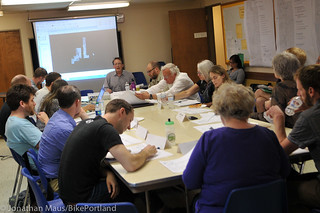
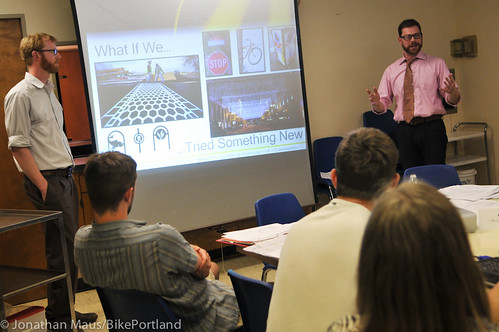
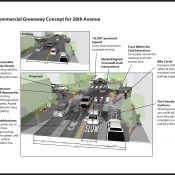
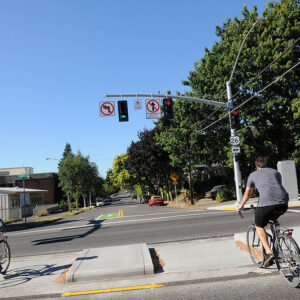

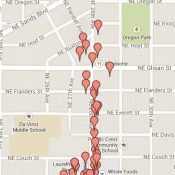
Thanks for reading.
BikePortland has served this community with independent community journalism since 2005. We rely on subscriptions from readers like you to survive. Your financial support is vital in keeping this valuable resource alive and well.
Please subscribe today to strengthen and expand our work.
If I may excerpt my comments on this very subject over the past few months:
November 18, 2013:
If the street can’t fit two directions of car & bike lanes each, can they not share? All bike trips involve mode mixing; narrow roads should be slowed appropriately.
March 14, 2014:
“I don’t need buffered lanes and less parking, I just don’t want cars breathing down my neck. What’s the commercial equivalent of a neighborhood greenway?”
“For those of you who feel like we’re missing our goals by not providing separated bike facilities on 28th, we just don’t feel we have a defensible argument to go in that direction until these questions [about parking] are answered. We got to be smarter than this.”
Why not? Because an ODOT study hasn’t yet been done?
Has PBOT never addressed this question?
What other data/arguments does PBOT not have on other future facilities?
Trying to figure out what other data PBOT doesn’t already have, and if every facility upgrade is going to take this route.
So why on earth did they put up their one way bike facility proposal to begin with? Clearly PBOT is operating reactionarily and does not have a strong goal/stance.
Newlands engaging in verbal gymnastics trying to explain this. I know there is an explanation. I just haven’t heard or thought of it yet.
From the very beginning they had “alternative” routes planned – 30th and 26th. 26 was nixed because they wanted to run the RoW of the path between the school building and the playground of Da Vinci Middle School. Didn’t hear much about that one after I sent the Da Vinci PTA board members emails on the subject. In the reply emails the PTA was split on what they thought about what to do on 28th, at least one liked 30th, not a one liked the middle school route – including the one who rides her kids to the school on a bike.
Though I was late and the beer pitcher had made the rounds (had I known I wouldn’t have bought my own pint – since I’m sure I (we) partially paid for each of the pitches that night) a few times before I got there, the Tugboat “meeting” was pretty discouraging. It was pretty clear that most of them didn’t care, and had their minds made up. The main push then was on the 26th route. Only one of the younger PDOT staffers seemed to care about the middle school issues, or was even interested in any of the 28th options.
The one lane idea was presented to me there – though more of as a “what if” situation. But even then outside input on that wasn’t considered either, because even then I mentioned the slight up hill on the street would make more sense to put the lane on the east lane (I ride a 43 year old 40+lbs three speed and I know there are people riding with cargo bikes where this slight hill makes a significant difference – something that I had noticed other people comment on that ride cargo bikes), but that too was brushed off.
That whole meeting was a compete waste of time, and honestly from what I’ve heard of the others, so were they.
Since the business owners have shown us that parking is important for business, and we know from PBOT’s own study that it is very highly utilized, perhaps the best approach would be to start metering the street parking and using the revenue stream to form a LID that would pay off bonds for the street improvement project. This solution is definitely more expensive, and we are forced into this being the only solution because parking cannot be removed.
I’ve asked before, so when are the Smart Parking meters going in?
Very highly utilized for a single Sat night from 7-8PM. I’m hoping this new study is a little more thorough than that.
It is highly utilized most of the week, but particularly in the evenings and weekend afternoons/evenings. Meters don’t have to charge all of the time. It could be free in the mornings, for example.
This is really cool. It’s not AAA but it’s what can be achieved at this time. At some point in the future, when things change, and business owners understand the larger picture, they’ll be less hesitant.
On another note, why isn’t some entrepreneurial type building car parkades near shopping districts? We know that major streets someday will no longer be able to have parking on them, even if we continued down the car-only mono modal path, they would have to remove parking to accommodate another lane of car traffic. Loss of parking spots is inevitable one way or another.
…why isn’t some entrepreneurial type building car parkades near shopping districts?
Because it’s expensive and who would pay for it when there is “free” parking on the street (that we all subsidize)?
“Given the limitations in PBOT’s plans and the absence of political or public will to remove auto parking on both sides of 28th in order to install a separated bike lane”
I’m curious when there has been an absence of “public will” to remove auto parking. Was there some survey or poll done (besides the business owners)?
i think they mean our LLC citizens, not the flesh and blood citizenry that are not invited to these meetings.
“We made that decision long before we received the petition.”
This just confirms for me that PBOT uses these advisory committees as a way to rubber-stamp what they intended to do all along…What a waste of the public’s time.
I had the same feeling, and I agree that it’s a shame to invite the public to volunteer their time and thoughts to the process if that’s the case. What’s more, the meetings are staffed by City employees, some of whom are probably paid overtime, and include lots of not-cheap presentation materials, so they’re just plain expensive for everyone.
Seeing as the 50s bikeway is still no built (and 1.5 years behind schedule), I wouldn’t hold my breath on this happening next year.
Agree with metered parking. Tired of the “our parking is so valuable we can’t afford to lose it…but lets give it away for free”. If it is really that valuable, start charging for it and encourage turn around and use by customers!
Free parking is the new banks: too big to fail
I was out of town the last couple days and didn’t get to respond to the earlier post, so I’ll just say now that this new proposal is great! I like it a lot better than PBOT’s earlier asymmetric design. Let’s do it!
And then let’s talk about all the other places in town where we have narrow streets through vibrant commercial districts, and we could apply the exact same configuration, Just off the top of my head, I’m thinking of Clinton and maybe Division too, Alberta, Mississippi, and Belmont. I’m sure there I’ll come up with many more, given about 30 seconds to think about it.
To me one of the brilliant aspects of the proposal is a yellow advisory sign posting a 10 MPH recommended speed. I realize 20mph is the lowest speed limit that we can apply under state law, but that doesn’t mean we can’t post a lower advisory speed. It seems most Oregonians don’t understand the difference between advisory and regulatory signs anyway.
What I don’t quite like is the diamond sign above the “10 mph” sign having just a bicycle symbol above it. Some people will interpret that to mean the 10mph advisory speed applies just to bikes. Not sure what would be better, though … maybe a sign with both a bike and a pedestrian symbol on it? Maybe just the word “CONGESTION” (already in widespread use)?
There is plenty of defensible data to support this idea.
+1
“”Even if we could achieve a really great enhanced, shared environment on 28th — which I’m hoping… we can do a dramatic improvement — it would still not meet our threshold for the ‘interested but concerned’.”
I think it’s time for PBOT to reconsider those famous groupings of people and bikes, and the thresholds they think are necessary for each. The groupings are way too broad.
I can’t be the only person who has transitioned from “haven’t been on a bike for 40 years” to “daily commuter” (and maybe to “sold my car”), but who still feels that “interested but concerned” describes her better than the other big categories.
My transition, probably like a lot of people’s, took place because there were some bike lanes, lots of quiet back streets, and a few neighborhood greenways that were useful to me. Sometimes, for my own feeling of safety, I had to get off and walk my bike, then little by little, I would dare to take the lane when I had the nerve–which I still lack a lot of the time.
Maybe Dutch-class separated facilities will bring in more of the 8-80s, but I think relatively safe (or safe-feeling) connectivity has the power to capture a whole lot of potential bike riders like me and help them become a little stronger and a little more fearless over time, even though they will never actually fit the “strong and fearless” category.
I’d like to see PBOT develop a new threshold–which would include the Commercial Greenway concept–for a more nuanced grouping of potential bike-riders.
Do even half of you crying for the “interested by concerned” even know what it means?
I quote there are two types of people:
1)Not very comfortable, interested in biking
more
2)Not very comfortable, currently cycling
for transportation but not interested in
biking more
http://docs.trb.org/prp/13-5213.pdf
table 1 little more than 1/3 down the page. But read the whole document please.
If you actually read the article/study/survey you’ll note that the titles for the riders were defined before the survey even took place. Riders and rider preferences didn’t define these terms, the people that took the survey were stuffed into these titles.
Private citizen with a “plan”:
“…he’s optimistic that PBOT…will incorporate some of its elements …”
PBOT project manager who helps pick design:
“Some of these ideas will take a lot of evolution for PBOT to get to… “
*sigh*
This would be the sort of evolution where PBOT learns to admit they were wrong.
I was at the meeting last night, which was my first one. I went to see Kirk’s new presentation, and the reaction to it. I was impressed with how much time Newlands gave the committee for questions, comments and input. If I were to guess, at the LAST PUBLIC MEETING, there couldn’t have been more than 2 or 3 people there like myself who weren’t on the committee, owned a business, involved in a neighborhood association or advocacy, and weren’t Jonathon Maus. I easily could have interjected, asking questions or voicing my concern, but felt Kirk and some others were saying what I would say. My point is, I realized if more of us computer chair advocates got to more of these public meetings, things might go more our way. Maybe if we went out and showed this new presentation to all the petition signers, things could get better. I hope I do what I say. That is all. PS- There was free pizza! Cheers.
i attended two out of three of the public open houses and made my voice heard. these stakeholders meetings are not advertised by pbot and the only reason we knew where it was going to be held was due to jonathan’s inside information. while i support the idea of commercial greenways (they are called winkelnerfen in holland) lets not forget who did a run around the public process.
Yes, the only place I heard about any of the Foster SAC meetings was from bikeportland. I do wonder if PBOT tries to keep the meetings small. And honestly if you’re not on the SAC, you can say your piece, but will it actually mean/change anything? Maybe, but definitely not a guarantee.
Love this commercial greenway concept!
This! So very this!
The ‘interested but concerned’ is, by Geller’s estimate, about 60% of all people. Surely in a group that broad, there are a range of different abilities and comfort levels. I often hear the term used interchangeably with “8 to 80,” as though a 30-something that hasn’t cycled in a while is somehow the same as an 8-year old trying to find his or her legs.
It’d be useful for this model to take the next step and break down the IBC into some useful subcategories so we can be more deliberate about what speed folks will tolerate, how much exposure to traffic they’re willing to bear, etc. My hunch is that something like a Commercial Greenway will appeal to some, but not all, of this massive 60% of the population. I’d love to have the information to nail down exactly how much of it…
I sometimes wonder if projects that would improve cycling for the majority of cyclists with roughly average capabilities are being held hostage to the perceived needs of a few cyclists with the very lowest capabilities.
Setting aside the small portion of the 20’s bikeway that runs from Stark to Glisan, I would like to see more updates on this blog about other areas of this bikeway which also have great impact to many street users. I am specifically interested in the area South of SE Division to SE Steele. Bike lanes are way too narrow and inadequate, here. City’s approach seems to be ignoring fact that many users take this route on their way to downtown (as opposed to heading north on the 20’s bikeway). During the planning meeting at Cleveland HS, they had some proposals for this area (like splitting bike traffic as North vs. South onto different streets (26th and 28th)), although they did not seem open to any new proposals.
In areas where there is not a restriction of tight commercial buildings or developments already existing, PBOT needs to think like BES and not be afraid to cut concrete curbs, remove trees, move signs, poles, and make a bigger space. If there is no car parking on the street, why does there need to be a “parking strip” between the sidewalk and the road? Especially when the bike lane is 3 feet wide.
Hi Bald One,
I hear you loud and clear. We are planning to share a complete look at PBOT’s plans for the entire route… But I’m waiting until we can get more information from PBOT. Stay tuned.
This sounds like an excellent idea to try. Since it is primarily an experiment to see if it works because of the perceived NEED for parking, it is obviously in enough demand to price. Hence, we need to Meter the area, with residential parking permits surrounding the metered zone, to pay for this “Terrific Compromise.”
In the meantime, the 20’s parallel RESIDENTIAL GREENWAY can be built on 30th next year as planned…Just please PBOT…remove those small number of spaces between Stark and Wasco. If you create bottleneck here because of a few spaces this project will fail. There is always plenty of parking on Sandy.
without a separate bike lane or a center barrier drivers will still pass dangerously close…
I think – someone correct me if I’m wrong – the idea would be that on that several-block stretch of 28th, there wold be very little passing, because cars would be driving at 10-15 mph, similar to the speed of most bicyclists on flat ground.
I confess that, personally. I might not always want to be stuck slow-pedaling behind a line of cars themselves stuck behind some bicyclist noodling along at 10 mph. But in that case I can just take an alternative route, and hopefully drivers in a hurry will as well.
From Burnside to Sandy is 1/4 mile to Multnomah is 1/2 mile. Unless it is really slow, I can handle that, and I tend to ride on the faster side. Honestly, if built I hope (and think it might) become so popular that I want to avoid it if I’m in a hurry on a Saturday afternoon or a Friday Evening. That would be success.
Not true at all. Most (yes there is the occasional a-hole) drivers will give you more room and pass at a slower speed if you’re riding outside the door zone. Even slower and more room than if you’re in a bike lane.
For them to pass they must slow down, and wait for an opening in the opposing lane. To pass you they must put themselves in a more dangerous road position. And it’s funny how much more carefully they (we) drive when they(we) are the one putting themselves in jeopardy.
This commercial greenway idea is interesting. I’m all for giving it a go but I still don’t understand PBOT’s desire to keep so much of this section of 28th a free parking lot. It seems like the main purpose of a road should be prioritized to accommodate traveling…by bike, car and/or foot. Not parking. With this kind of thinking we’ll end up with stop signs on roundabouts. Oh wait.
Lets all show up at stakeholder’s meetings with some really big stakes!
I think the idea that another new study will change the conversation is a bit naive. This sounds like embattled city staff are retreating into the neutrality of another study.
What we really need is more thoughtful people speaking up, building relationships, and organizing in a sustained way for what we already know: Creating more, safe space for pedestrians and cyclists in our streets has multiple health, economic, and environmental benefits for our neighborhoods and our planet.
And just as a side note, I’ve been thinking about how to reduce the cost of the textured concrete/cobblestone sections for the door zone area. And see no reason why something like detectable warning strips couldn’t be used. (You all have seen them)
http://www.detectable-warning.com/products-alertcast.shtml
They come in 2′ x 5′ strips, you could offset them 1′ off the inner edge of the parking lanes for the 3′ door clearance. They can be applied to existing surfaces, this particular one can handle 30,000 lbs of compression so it can handle all the commercial truck traffic on the street.
If you were to put these on both side of the street for the quarter mile stretch without interruptions you’d need 528 of them.
Not sure how much that number reduces with interruptions since there would be no need for the strips across driveways and through intersections. And to further reduce the number you could cut it half by applying on every 10′.
Oh yeah, and the purchase price (retail no bulk discounts- through google shopping) comes out to roughly $200 a panel. You could reduce the costs more by going with the 2′ x 4′ panels which go for around $100-130 a panel.
oh yeah, and should they somehow get damaged, they’re replaceable.